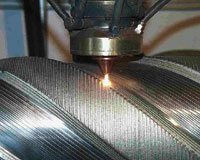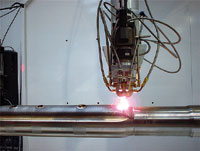 Technology from Europe: Technology from Europe:
France, Germany
Hardsurfacing nonmagnetic steel for oil drilling tools
Since it was introduced in 1926 by the Stoody brothers, hardsurfacing- – using the oxyacetylene welding process to apply a low-carbon steel tube filled with tungsten carbide – has proven efficient. But the process is limited in that it must be applied at a high temperature, and this oxidizes the deposit and the area surrounding the deposit.
The use of an electric arc to make the deposits is both damaging to the substrate (by excessive penetration into the base material) and to the carbide particles as they are placed in solution with the heat of the arc.
The introduction of a welding rope made from a nickel, chromium, boron, silicon alloy to form the matrix, and tungsten carbide to provide the wear element, has significantly improved hardsurfacing applications, as well as wear life. The introduction of spherical cast carbide into the product has further improved its application and life. This product is now in wide use in stabilizers and drill bits.
Even with these improvements to welding consumables, the hardsurfacing of tools made from nonmagnetic steel was a real problem. This difficulty is due to the differences in coefficient of thermal expansion between the base material and the hardsurfacing.
For example, low-carbon steel has a coefficient of expansion between 0°C and 600°C of 8 ×10-6, and most of the nonmagnetic steel used in oil drilling applications has a coefficient of 15 ×10-6 in that temperature range. This great difference in the cooling of a hardsurface deposit introduces internal stresses, resulting in failure between the hardsurface and the weld deposit.
The problem has been overcome by the French firm Technogenia. Based in Saint Jorioz, the company uses a laser-cladding process, where a powerful laser is married with multi-axis positioning equipment and equipped with a special coaxial nozzle. This arrangement melts the substrate surface and filler metal, thereby forming a metallurgical bond between the two. Computer Numerical Control allows placement of the cladding with precise accuracy and reproducibility.
This machine arrangement and the company’s unique Spherical Cast Tungsten, blended with a special matrix, produces a deposit branded Lasercarb. To overcome the problems of applying carbide-containing deposits on nonmagnetic material, the following process is used.
 |
 |
Two nonmagnetic parts being hardsurfaced with the new laser process.
|
|
A layer of soft nonmagnetic material is deposited directly to the nonmagnetic base material. Atop this “butter” layer, a deposit of Spherical Cast Tungsten Carbide is applied by the laser. Using the laser for this procedure limits damage to the nonmagnetic base by controlling the heat-affected zone and penetration to a minimum. The carbide deposit is extremely homogeneous in thickness and offers the maximum in wear resistance coupled with good corrosion resistance.
Hardfacing on steel, stainless steel and nonmagnetic steel can be accomplished. This process is particularly useful for nonmagnetic drilling tools. Major companies are now using this hardfacing on their drilling equipment. 
|

 Technology from Europe:
Technology from Europe:


